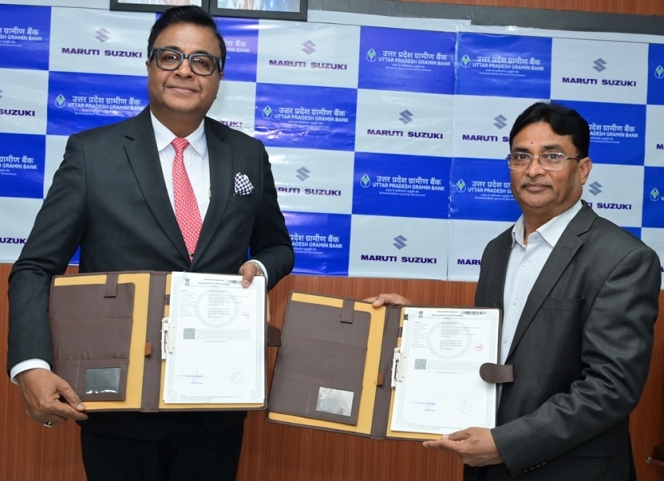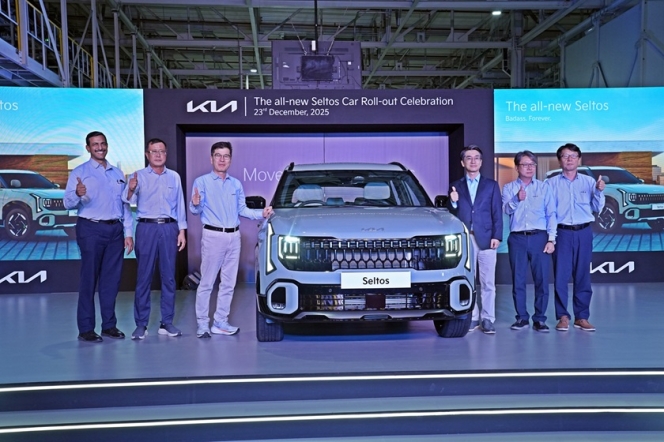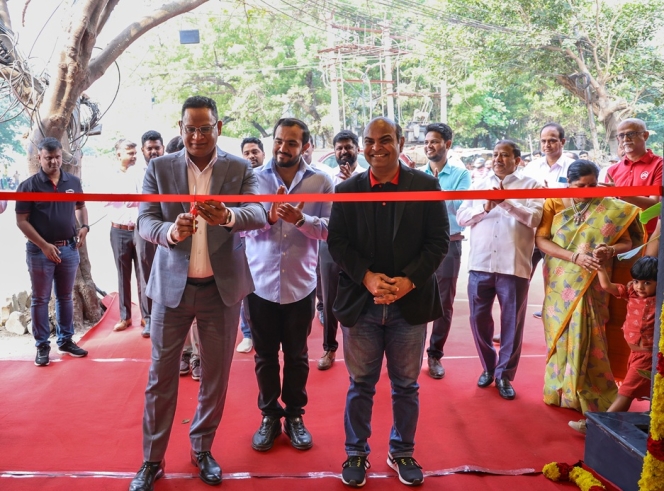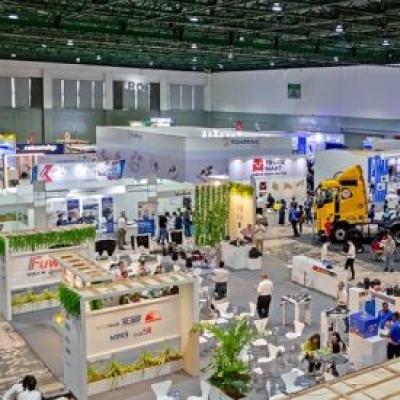Auto Industry Hails Union Budget Announcements
- By MT Bureau
- February 01, 2022

While presenting the Union Budget today, Finance Minister Nirmala Sitharaman announced a new battery swapping technology in India and steps to boost the adoption of electric vehicles in India. The industry leaders generally welcomed the budget. Following are the reactions to the newly announced Budget from industry bodies and organisations.
FADA Welcomes Govt Efforts
Vinkesh Gulati, President, FADA, said, “Union Budget 2022 seeks to lay the foundation for the next 25 years, from India@75 to India@100. With PM’s ‘Gati Shakti National Master Plan’, a INR 100-lakh crore project for building comprehensive infrastructure in India, it will be a significant step towards development. The budget has attempted to focus on each of the sectors and has also tried to stimulate the economy after the pandemic slowdown. FADA welcomes and supports the government's efforts and initiatives towards Electric Mobility. There is a clear emphasis on creative, sustainable and innovative business models. Battery Swapping & Energy as a Service (EAAS) will surely help accelerate the transition towards Clean Mobility. The development of special mobility zones for electric vehicles and promoting clean technology for public transport validate government commitment to E-mobility, which would boost confidence in the EV industry in terms of manufacturing, sales, and create a sense of assurance among customers. The government's plans for developing 25,000 kilometers of new highways will result in a push for infrastructure spending, which will result in an increase in Commercial Vehicle sales, as well as an addition of 2,000 kilometers of road under a new scheme known as 'Kavach' will be an additional benefit to the revival of this segment. With the extension of the ECLG scheme, it is a remarkable move by the government to support the MSME sector coming out of the slowdown caused by pandemics.”
Gulati added, “The rural India has generally been the key driver for entry level passenger vehicle segment and two-wheeler space. With government plans on INR 2.3 lakh crore direct payment as MSP to farmers, it will work as a booster for two-wheeler, tractor and entry-level PV sector sales. However, an additional duty of rupees 2/ litre on unblended fuel from October 2022 could play a spoilsport for the already stressed 2W industry.”
Budget Boosts EV Industry
Sohinder Gill, Director General, Society of Manufacturers of Electric Vehicles (SMEV), said, “We welcome the measures announced by the honourable Finance Minister, today. The budget for 2022–23 gives a huge impetus to the electric vehicle (EV) industry. Introducing the battery swapping policy and recognising battery or energy as a service will help to develop EV infrastructure and increase the use of EVs in public transportation. It would motivate businesses engaged in delivery and ride aggregation businesses to incorporate EVs into their fleet. It will create new avenues for companies to venture into the business of battery swapping. Additionally, creating special clean zones will further accelerate the adoption of EVs and spread awareness amongst the citizens. The move will benefit the whole segment, i.e E2W, E3W, E-cars, and buses. The budget also provides attention to the need for skilled resources in the industry. Introducing new skill programs in ITI will bridge the skill gap that currently exists in the industry. The industry would be happy to work with the government to devise customized courses to meet the demands of the EV industry. Overall, the budget aims at strengthening the whole ecosystem of the EV industry, which will spur the demand for green vehicles.”
Additional Opportunities
P B Balaji, Group CFO, Tata Motors, said, “Budget 2022 is an articulation of purposeful intent enabled by a clear action plan. Building on the excellent budget of last year, the government has wisely continued on the path of prioritising economic growth with calibrated fiscal prudence. For the Indian automobile sector, which is a significant contributor to the nation’s GDP, the budget offers continuity and also additional opportunities to drive multi-year growth. Specifically, the robust increase in capex by 35.4 percent to INR 7.5 lakh crore and a comprehensive investment plan for infrastructure is a significant growth booster. Additionally, the launch of the well-conceived PM Gati Shakti program for multi-modal transport including 100 cargo terminals and investments in 25000Kms of highways, apart from investments in ports and metros is an excellent development that will help create a world-class transport infrastructure in the country. This will reduce logistics costs and transit times, increase employment and make us globally competitive with avenues for better and efficient mobility solutions. Additionally, plans to create EV charging infrastructure including national policy for battery swapping which when combined with the already announced Automotive PLI scheme, furthers the agenda for green mobility. Tata Motors welcomes this balanced, thought through budget.”
Bolster Electric Mobility
Rajesh Jejurikar, Executive Director, Auto & Farm Sectors, Mahindra and Mahindra Ltd, said, “The roadmap laid out to usher in sustainable mobility by the honourable Finance Minister in the Union Budget 2022-23 will bolster the electric mobility adoption in India. Battery swapping can offer a practical alternative to increase adoption of electric vehicles. As part of our Last Mile Mobility, we look forward to working with the government, policymakers and our partners to formulate and implement the battery swapping policy. This will include introducing interoperability standards as well as driving innovation in Battery as a Service business models.”
Huge Impetus on Rural Growth
Nagesh Basavanhalli, Group CEO and MD, Greaves Cotton Limited, “The Union Budget 2022 has some important announcements to accelerate economic growth by focusing on 4 core pillars of productivity, climate action, financing investment and PM Gati Shakti Programme which will help strengthen our infrastructure and MSME sector. The expansion of the National Highway network will provide better connectivity to our towns and cities and strengthen the supply chain network. Overall huge impetus on rural growth through various schemes and technological intervention will help create more rural jobs and thereby create more demand from rural and semi-urban areas. The production linked incentives in several sectors announced by the government will help create more employment opportunities for the people.
Basavanhalli added, “Digital ecosystem for skilling and livelihood through online training is a step in the right direction as this is a critical need of the hour by the industry. From the auto and EV sector's point of view, the battery swapping policy will boost the adoption of EV. Further, the government’s move to encourage the private sector’s involvement to create sustainable and innovative business models for battery and energy as a service, too, will be a game-changer for the growth of the entire EV ecosystem of the country.”
Invest in India
Ujjwal Jain, CEO and Founder, WealtDesk, “The government continued with a growth-oriented budget and took charge from the front. This can be seen by the 35.4 percent increase in CAPEX while maintaining a manageable fiscal deficit and very conservative tax revenue targets. Make in India continues to get the push - to boost defence innovation, 68 per cent of the capital procurement budget in defence will be earmarked for the domestic industry in 2022-23. The Unified Logistics Interface Platform (ULIP) was also announced in the budget speech, which will enhance efficiency and reduce logistics costs in the country. The other highlight was the 30 percent tax on Virtual Digital Assets with no set-offs and TDS of 1 percent. Bringing the Virtual Digital Assets into the tax net is a smart move with a forward-looking approach. The finance minister also announced the creation of a digital currency by the RBI. The government will form an expert panel to attract and encourage PE/VC investments. The panel will help identify the appropriate measures to increase investments and establish friendly policies for investors bringing foreign capital to Indian startups. This move can help reduce risks faced by foreign investors when investing in Indian startups. In all, the key takeaway from the budget can be "Invest in India".
Futuristic Budget
Sulajja Firodia Motwani, Founder and CEO, Kinetic Green, said, “Budget 2022 is a futuristic budget with focus on deployment of advanced technology like EV, green mobility and digitisation. The Budget 2022 announced by Hon’ble Finance Minister today is positive for the Electric Vehicle sector, which reinforced the Indian Government’s commitment to accelerating EV and green mobility eco-system in India. FM has announced that to foster the creation of electric vehicle ecosystem, a battery swapping policy will be devised. In order to scale up battery stations, a battery swapping policy will be brought out with inter-operability standards. There is an announcement on shift to use of public transport in urban areas by clean tech and with special e-mobility zones. Green Energy & Clean Mobility systems have immense potential to assist sustainable development & modernise the country. This will further enhance connectivity and digitization of the auto sector and is expected to help automotive in a greater way. The Minister also emphasized that private sector will be encouraged to develop sustainable and innovative models for battery and energy as a service which will increase efficiency in EV ecosystem. I am confident that this move will encourage manufacturers to enhance investments in this sector. Further announcements such as ramp up of capital expenditure and spending on infrastructure will boost economic growth. It is a futuristic budget with focus on the greening of economy and digital technology. We welcome this budget and appreciate Government’s steps to promote electric vehicles and tackle pollution in our cities.”
Growth-oriented Budget
Suyash Gupta, Director General, Indian Auto LPG Coalition, said: ''With India remaining the best-performing economy among the larger economies as duly highlighted by the budget, the budget has stayed the course in terms of remaining a growth-oriented one. In terms of promotion of cleaner mobility, while the government’s intent to encourage battery swapping technology with an eye on galvanizing electric mobility is appreciated, it still remains to be seen what more is there in the fine print for promotion of cleaner alternative fuels. At the same time, the provision for sovereign green bonds with the aim of reducing the carbon intensity of the economy must be appreciated. Also, the encouragement of agroforestry, the extension of PLI schemes to the manufacturing of solar PV modules will further help in pursuing a more carbon-free economic pathway for the country. It must also be added that the increase of excise on unblended fuel will also help to some extent in achieving cleaner mobility. However, the bigger picture with regard to air quality has been missed. Electric is a while away. What does the country do in the interim? Low hanging fruits like Auto LPG need to be acknowledged, which could bring immediate relief to the urban air pollution.''
Forward-looking Budget
Parag Satpute, Managing Director, Bridgestone India, said, “This is a forward-looking budget that focuses on not only the economic health of the country but also takes into account physical and mental health. This is indeed a major milestone in India. The PM Gati Shakti plan and the corresponding announcement of additional 25, 000 km of roads will spur growth in the mobility sector. The government’s initiative on electric vehicles and the announcement on a battery swapping policy is a major boost to the nascent EV sector and will boost customer confidence in EVs.”
Intention to Revive Travel Industry
Manish Rathi, CEO & Co-founder, IntrCity, said, "We welcome the government's commitment to expanding the national highway network by 25,000 kilometres this fiscal year. The Finance Minister needs to be complimented for her vision to usher 9.2 percent economic growth. This is very much possible in view of the allocation of INR 20,000 crores to the National Highway System. This shows the government's intention to revive and transform the beleaguered travel and transport industry. We endorse the GOI's aim to improve road connectivity by redesigning the roads in hilly areas under the Parvat Mala initiative, which will improve connectivity for commuters. The government seems inclined to strengthen and support public transport infrastructure in urban areas and allocate funds through low-interest loans to small travel operators; this is a good sign. These would help us expand our SmartBus fleet's presence deep inside India's heart and provide comfortable, convenient, and safe mobility solutions in Tier 2 and Tier 3 cities."
Progressive Budget
Suresh KV, President and Regional Head, ZF India, said, “Union budget 2022 is progressive and with the continuous support of the government we are optimistic that the industry will soon return to the path of growth in 2022. The announcement of allocation of INR 20,000 crores for infrastructure projects and the announcement of 25,000 kms of additional National Highway network during FY 22-23, is a much welcome move. This will have a positive impact on the transportation industry and the auto sector, at large. The Government focus on green mobility was evident and the special new battery swapping policy for the EV infrastructure will boost the EV ecosystem and lead to faster adoption. The special focus towards clean technologies and electric vehicles for public transport will positively impact companies manufacturing and supplying technology to electric buses and commercial vehicles. The move to boost the rural economy with the announcement of MSP payment of INR 2.73 lakh crores coupled with other benefits, will aid the farming sector and is bound to enhance the rural economy and sentiments. The
concessional corporate tax of 15 percent for more than one year till March 2024 will provide the much-needed impetus for the Covid impacted manufacturing segment. This is further bolstered by the eagerly anticipated re-look at the SEZ act, which will boost the competitiveness of the Indian manufacturers. Overall, the budget 2022 has several measures that are likely to create a positive impact on the Indian auto sector that has been gravely hit by the COVID 19 pandemic, and we at ZF in India welcome this”. (MT)
Citroen India Delivers 51 C3 CNG Vehicles To Luthra Group
- By MT Bureau
- December 24, 2025
Citroen India, in partnership with its dealership La Maison Nanavati, has completed the handover of 51 Citroen C3 CNG vehicles to the Luthra Group. The ceremony took place at the Luthra Group’s headquarters in Surat.
The delivery is part of Citroen's strategy to expand its presence in tier-II and tier-III markets by providing mobility solutions to businesses and individuals.
The Citroen C3 CNG is designed for high-usage environments and daily commutes. The model includes several features tailored for the Indian market, integration of a factory-fitted CNG kit to manage running costs. A suspension system tuned specifically for local road conditions. Provisions for cabin space and air-conditioning systems designed for high-ambient temperatures.
The handover to Luthra Group represents the brand's focus on cost-efficient transportation. By targeting the regional business sector, Citroen India aims to strengthen its footprint in Gujarat and the broader Indian mobility market.
The C3 CNG is positioned as a solution for users requiring reliability and low operating expenses without compromising on ride comfort.
Maruti Suzuki India Partners Uttar Pradesh Gramin Bank For Retail Financing
- By MT Bureau
- December 24, 2025

Maruti Suzuki India has signed a Memorandum of Understanding (MoU) with Uttar Pradesh Gramin Bank, a regional rural bank, for vehicle retail financing partnership on new cars, pre-owned vehicles and commercial vehicles.
This collaboration marks the 50th retail finance partner for Maruti Suzuki India. The partnership is intended to use the bank’s network to provide credit options to a range of customer profiles, particularly in rural and semi-urban regions.
The partnership aims to increase the accessibility of Maruti Suzuki products through, tailored finance schemes designed for rural and regional customers.
Partho Banerjee, Senior Executive Officer, Marketing & Sales, Maruti Suzuki India, said, “Our partnership with Uttar Pradesh Gramin Bank marks a significant milestone as we onboard our 50th retail finance partner. This reinforces our commitment to making car ownership simpler and more affordable for customers across India. By expanding our reach through this strategic alliance, we aim to empower buyers with competitive, customer-friendly financing solutions that enhance the overall purchase experience. We remain focused on delivering seamless, tailored finance options, and this collaboration strengthens our vision of providing the Joy of Mobility to aspiring Indian consumers.”
Yadav S. Thakur, Chairman, Uttar Pradesh Gramin Bank, said, “At Uttar Pradesh Gramin Bank, empowering customer aspirations is at the heart of everything we do. Our partnership with Maruti Suzuki, a leader in the automotive industry, is a strategic step towards enhancing our service offerings and delivering greater value to our customers. This collaboration aligns with our 'Customer-First' mission, enabling us to provide accessible and affordable vehicle financing solutions. We look forward to helping more individuals and families across the country realise their dream of owning a Maruti Suzuki vehicle.”
Kia India Commences Production Of New Seltos In Anantapur
- By MT Bureau
- December 23, 2025

Kia India has started production of the latest generation Seltos at its manufacturing facility in Anantapur. The company has confirmed that prices for the mid-SUV will be announced on 2 January 2026.
The Anantapur plant, established in 2019, serves as a hub for both the Indian domestic market and international exports. The facility uses automation and a local workforce to manufacture the Seltos, which was the first model produced by the company in India.
The new model is built on Kia’s K3 platform, which has been engineered to increase structural rigidity and improve suspension damping. The vehicle has grown in size compared to its predecessor to increase cabin space and stability. It has 4,460 mm of length, 1,830 mm of width and a wheelbase of 2,690 mm.
The exterior design follows the ‘Opposites United’ philosophy, featuring a ‘Digital Tiger Face,’ LED projection headlamps, and alloy wheels with neon brake callipers.
The vehicle integrates several digital interfaces and driver assistance systems. It features an upgraded Kia Connect 2.0 suite with over-the-air (OTA) software updates and a proximity unlock function.
In terms of safety, it gets 24 features as standard, while ADAS Level 2 offers 21 autonomous features to assist the driver. The Kia Seltos SUV comes with three engine options – 1.5-litre Petrol producing 115 PS of power and 144 Nm of torque, 1.5 T-GDI Petrol producing 160 PS of power and 253 Nm of torque and a 1.5-litre diesel engine producing 116 PS of power and 250 Nm of torque.
Transmission choices include a 6-speed manual (6MT), intelligent manual (6iMT), IVT, 7-speed dual-clutch (7DCT) and a 6-speed automatic (6AT). The model will be sold in four trims – HTE, HTK, HTX and GTX – with additional option variants and an X-Line styling pack.
Gwanggu Lee, Managing Director & CEO, Kia India, said, “The roll-out of the All-New Kia Seltos marks a proud milestone for Kia India. Seltos has long set benchmarks in the mid-SUV segment, and this new generation represents a bigger, bolder, and more progressive evolution shaped by insights from Indian customers. With production now underway at our Anantapur facility, our teams are fully geared to ensure customers can take delivery of their all-new Seltos without long waiting periods. We are confident the all-new Seltos will once again redefine expectations in the segment and strengthen Kia’s leadership in India."
“The new Seltos looks fantastic. The Anantapur team, together with our supplier partners, have done an outstanding job in delivering our customers a great looking, significantly bigger, technologically progressive and safe vehicle with impressive functionality and connectivity,” he said.
- Citroen India
- Jeep
- Stellantis
- Citroen 2.0
- Shailesh Hazela
- Kumar Priyesh
- Sree Venkata Teja Kethineni
- VTK Automobiles
Citroen India Opens 126th Outlet In Chennai Under Citroen 2.0 Strategy
- By MT Bureau
- December 23, 2025

Stellantis-owned French automotive brand Citroen India has inaugurated its 126th point of sales and service (POS&S) facility in Chennai, continuing the expansion of its network under the ‘Citroen 2.0 – Shift Into The New’ strategy.
The new 3S (Sales, Service and Spares) facility is located at Chitlapakkam, near Chrompet. It is an extension of the partnership with VTK Automobiles, which now operates five Citroen touchpoints in the city. The outlet functions as a ‘Stellantis Brand House,’ allowing customers to access both Citroen and Jeep brands within a single space.
Since the announcement of the Citroen 2.0 strategy, the brand has increased its network by 48.6 percent. Over the last six months, the company added 43 points of sale through its network expansion programmes. Citroen expects to reach a total of 135 outlets by the end of the year, with further operations planned for the north, west, and east of India.
The strategy focuses on several pillars – deepening the domestic supply chain for India-centric products. Expanding the dealer footprint into Tier 2 and Tier 3 locations. Using digital tools and unified spaces for sales and aftersales services.
Shailesh Hazela, CEO and Managing Director, Stellantis India, said, “The expansion of Stellantis network further with VTK dealership in Chennai marks another important step in Citroen and Jeep India’s network growth strategy. Chennai is a key market for us, and this upgraded facility will enable us to serve our customers better with a seamless sales and ownership experience. Aligned with our Citroen 2.0 strategy, we remain committed to strengthening our dealer partnerships and building a robust, customer-centric network across the country.”
Kumar Priyesh, Director Automotive Brands, Stellantis India, said, “We have grown our network by almost 48.6 percent since we announced the Citroen 2.0 strategy and have been able to expand our operations in different parts of country: adding tier 2/3 locations while further strengthening in Metro/ Tier 1 cities. Through project Visitar, Network Expansion Program and expansion in new geographies we added over 43 POS in the last 6 months and are already in advanced stages to start additional operations in North, West and Eastern parts of the country and expected to close the year with 135 POS for Citroen.”
Sree Venkata Teja Kethineni, Dealer Principal, VTK Automobiles, said, “We’re happy to partner to this pivotal shift in automotive retail, proudly representing Jeep and Citroen. Our dual-brand strategy empowers us to deliver a truly elevated and distinctive experience – whether customers seek rugged performance or refined sophistication. With passion, professionalism and personalised care at the core, our team is committed to exceeding expectations and upholding the global standards these iconic brands represent.”
The facility includes a service centre equipped with diagnostics and digital tools. Staff members are trained across both Jeep and Citroen product lines to provide technical support and product information.






Comments (0)
ADD COMMENT